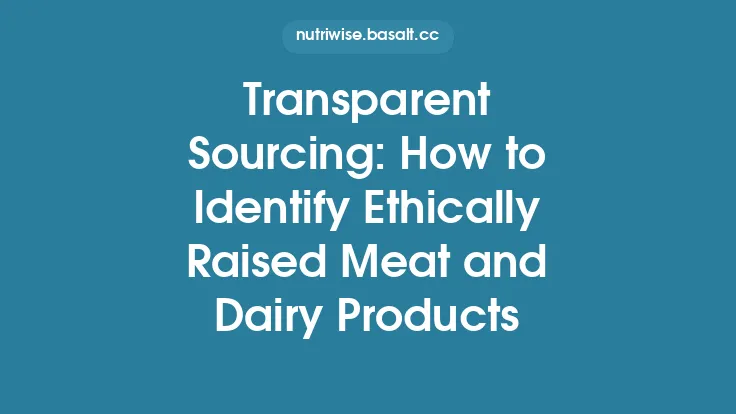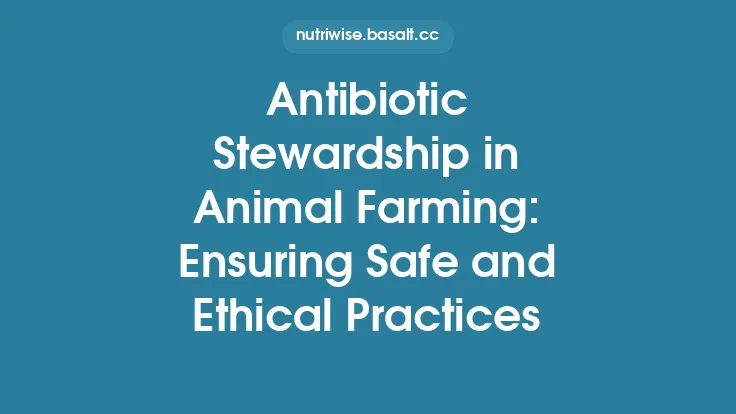The global demand for dairy products continues to rise, yet consumers are increasingly aware that the way milk is produced matters as much as the taste of the final product. Ethical dairy farming places the health and comfort of the cow at the core of every decision, from the layout of the barn to the daily rhythm of milking. By aligning farm practices with the physiological and psychological needs of dairy cattle, producers can achieve a system that is both humane and economically sustainable. The following sections explore the key components of an ethically‑focused dairy operation, offering practical guidance that remains relevant regardless of farm size, climate, or market conditions.
Designing Cow‑Friendly Housing
Space Allocation and Grouping
Cows are herd animals with a strong preference for stable social structures. Providing at least 1.5 – 2.0 m² of usable floor space per animal in lying areas allows each cow to rest without competition. Grouping cows by age, lactation stage, and production level reduces social tension and minimizes the risk of aggressive encounters. Rotating groups periodically can prevent the formation of overly dominant hierarchies while still preserving familiar companions.
Bedding Materials and Management
A comfortable lying surface is essential for udder health, hoof integrity, and overall welfare. Deep‑bedded pack barns using sand, straw, or processed wood shavings provide cushioning and promote natural lying behavior. Regular monitoring of moisture content (target < 30 % dry matter) prevents bacterial growth and reduces the incidence of mastitis. Automated manure removal systems can maintain dry bedding while minimizing labor.
Ventilation and Climate Control
Heat stress dramatically impairs milk yield and immune function. Effective ventilation—whether through natural airflow in open‑sided barns or mechanically assisted fans and tunnel ventilation—maintains a temperature‑humidity index (THI) below 68 for most breeds. In colder regions, insulated walls, radiant heaters, and controlled airflow prevent drafts while keeping ambient temperatures within the cow’s thermoneutral zone (5 – 25 °C).
Lighting Regimes
Cows respond to photoperiod cues that influence reproductive cycles and behavior. Providing 16 hours of low‑intensity, white light per day mimics natural daylight patterns, supporting regular estrous cycles and encouraging consistent feeding and milking schedules. Sudden changes in light intensity should be avoided to reduce stress.
Optimizing Nutrition for Health and Comfort
Balanced Rations Tailored to Production Stage
Nutrient requirements differ markedly between dry cows, early‑lactation heifers, and high‑producing lactating cows. Formulating rations based on precise dry‑matter intake (DMI) predictions—using tools such as the NRC (National Research Council) equations—ensures that each animal receives adequate energy, protein, minerals, and vitamins without excesses that could lead to metabolic disorders.
Forage Quality and Digestibility
High‑quality forages (e.g., alfalfa, clover, well‑matured grass) provide essential fiber that promotes rumen health and reduces the risk of acidosis. Regular testing for crude protein, neutral detergent fiber (NDF), and lignin content allows nutritionists to adjust supplementation rates and maintain optimal rumen pH (6.2 – 6.8).
Feeding Management and Access
Ad libitum access to clean water and feed reduces competition and encourages natural grazing or bunk‑feeding behavior. In tie‑stall or free‑stall systems, ensuring that feed bunks are positioned away from high‑traffic zones minimizes displacement of lower‑ranking cows. Automated feed dispensers can deliver consistent portions, reducing waste and ensuring uniform nutrient intake.
Supplementation for Specific Health Goals
Targeted supplements—such as rumen‑protected methionine for milk protein synthesis, calcium boluses for early‑lactation hypocalcemia, and omega‑3 fatty acids for anti‑inflammatory benefits—can enhance health outcomes when used judiciously. Regular blood profiling helps identify deficiencies before clinical signs appear.
Health Monitoring and Preventive Care
Routine Physical Examinations
Weekly visual checks for lameness, udder swelling, and body condition score (BCS) provide early warning signs of health issues. A BCS of 2.5 – 3.5 (on a 5‑point scale) is ideal for most lactating cows; deviations indicate under‑ or over‑conditioning, which can affect fertility and milk production.
Digital Health Sensors
Wearable accelerometers and rumination monitors track activity patterns, lying time, and chewing behavior. Deviations from baseline—such as reduced lying time or altered rumination bouts—often precede clinical disease by 24‑48 hours, allowing for prompt intervention.
Vaccination Protocols
A comprehensive vaccination schedule (e.g., bovine viral diarrhea virus, infectious bovine rhinotracheitis, leptospirosis) reduces the incidence of infectious diseases that can compromise welfare. Vaccines should be administered according to manufacturer guidelines and local veterinary recommendations.
Biosecurity Measures
Controlling the movement of people, equipment, and livestock between farms limits pathogen introduction. Designated clean and dirty zones, footbaths, and hand‑washing stations are simple yet effective barriers against disease spread.
Breeding Strategies that Prioritize Welfare
Selection for Functional Traits
While high milk yield remains a commercial goal, breeding programs that also emphasize functional traits—such as udder conformation, leg strength, and disease resistance—produce cows better suited to the farm environment. Genomic selection tools enable the identification of animals with favorable welfare‑related alleles early in life.
Controlled Insemination Timing
Artificial insemination (AI) performed during optimal estrus windows improves conception rates and reduces the need for repeat breeding, which can stress cows. Synchronization protocols that minimize hormonal manipulation are preferred, aligning reproductive management with animal comfort.
Limiting Excessive Production
Extremely high-producing cows are prone to metabolic disorders, mastitis, and reproductive failures. Setting realistic production targets (e.g., 8,000–10,000 kg per lactation for most Holsteins) balances economic returns with the physiological capacity of the animal.
Calf Rearing Practices that Support Long‑Term Well‑Being
Colostrum Management
Ensuring that each newborn receives at least 3 – 4 L of high‑quality colostrum within the first two hours of life provides passive immunity critical for disease resistance. Testing colostrum IgG concentration (target > 50 g/L) guarantees adequacy.
Individual Housing with Social Contact
While individual hutches protect calves from disease transmission, providing visual and tactile contact with peers (e.g., adjacent pens with shared fencing) satisfies social needs without compromising health. Transitioning to group pens at 4–6 weeks encourages natural social behavior.
Gradual Weaning Protocols
A step‑down weaning approach—reducing milk replacer over 7–10 days while simultaneously increasing solid feed—reduces stress and supports rumen development. Monitoring starter intake ensures calves meet the 1 kg/day threshold necessary for successful weaning.
Environmental Enrichment
Providing manipulable objects (e.g., ropes, balls) and textured flooring stimulates exploratory behavior, reducing stereotypies and promoting mental health during the critical early life stage.
Milking System Design and Routine Management
Gentle Milking Equipment
Milking machines equipped with low‑vacuum pulsators and soft liners minimize teat tissue damage. Regular calibration of vacuum levels (typically 38–42 kPa) and pulsation rates (60–90 cycles per minute) preserves teat health and reduces mastitis risk.
Milking Frequency and Timing
Twice‑daily milking remains the standard for most dairy operations, but offering a third milking session for high‑producing cows can improve udder health and milk yield without imposing excessive stress. Consistent milking intervals (approximately 12 hours) help maintain stable circadian rhythms.
Pre‑ and Post‑Milking Hygiene
Cleaning teats with warm water and a mild disinfectant before milking removes debris and reduces bacterial load. Post‑milking teat dipping with an approved antiseptic (e.g., iodine‑based) creates a protective barrier against pathogen entry.
Cow Flow Management
Designing milking parlors to allow a smooth, unhurried flow of cows reduces competition and bottlenecks. Free‑stall or rotary parlors with ample entry space and gentle curving lanes encourage calm movement and lower the incidence of injuries.
Environmental Enrichment and Social Needs
Comfortable Resting Areas
Providing multiple lying stalls per cow (ideally 1.2 – 1.5 stalls per animal) ensures that each individual can rest without interruption. Soft, clean bedding encourages longer lying bouts, which are essential for rumination and udder health.
Grazing Access and Forage Diversity
Even in confined systems, offering a daily “pasture‑like” paddock or a strip‑grazing area where cows can graze on fresh forage satisfies natural grazing instincts. Rotating these areas every 2–3 days prevents overgrazing and maintains plant diversity.
Social Interaction Zones
Designated “social zones” with low‑traffic pathways allow cows to interact, groom, and establish hierarchies without interference from feeding or milking activities. Observing these zones can provide valuable insight into herd dynamics and early signs of distress.
Managing Waste and Air Quality for Cow Comfort
Manure Handling Systems
Mechanical scrapers or flush‑water systems that rapidly remove manure from lying areas keep the environment dry and reduce ammonia emissions. Regular flushing of slurry pits and proper storage prevent odor buildup and protect respiratory health.
Air Filtration and Dust Control
Installing high‑efficiency particulate air (HEPA) filters in enclosed barns reduces inhalable dust and bacterial aerosols. Maintaining a minimum of 0.5 m/s air velocity across the barn floor helps disperse gases while avoiding drafts that could chill cows.
Water Quality Management
Providing clean, fresh water at a temperature of 10 – 15 °C encourages adequate intake, which is vital for digestion and thermoregulation. Routine testing for bacterial contamination (e.g., coliforms) ensures water safety.
Integrating Technology for Continuous Welfare Assessment
Automated Milking Data Analytics
Modern milking parlors generate real‑time data on milk yield, conductivity, and flow rate. Anomalies—such as sudden drops in yield or spikes in electrical conductivity—can flag early mastitis or udder edema, prompting immediate veterinary review.
Smart Barn Sensors
Networked temperature, humidity, and CO₂ sensors feed into a central dashboard, allowing farm managers to adjust ventilation or heating automatically. Alerts can be set for THI thresholds that trigger cooling interventions (e.g., misting fans).
Predictive Modeling
Machine‑learning algorithms that integrate feed intake, activity, and production data can predict health events (e.g., lameness, ketosis) weeks before clinical signs appear. Implementing such models reduces treatment costs and improves overall herd welfare.
Staff Training and Farm Culture
Education on Cow Behavior
Regular workshops that teach workers to read body language—such as ear position, tail movement, and vocalizations—enhance early detection of discomfort. Understanding natural herd dynamics fosters a more empathetic handling approach.
Standard Operating Procedures (SOPs)
Documented SOPs for milking, feeding, and health checks create consistency across shifts, reducing variability that can stress animals. SOPs should be reviewed annually and updated based on the latest research findings.
Well‑Being Incentives
Linking employee performance metrics to welfare outcomes (e.g., low lameness rates, high BCS scores) aligns staff motivation with ethical goals. Recognition programs and continuous professional development opportunities reinforce a culture of compassion.
Ethical Decision‑Making Throughout the Cow’s Life
Culling Based on Welfare Criteria
When a cow’s health deteriorates beyond reasonable treatment—such as chronic lameness unresponsive to therapy or repeated mastitis episodes—humane culling decisions should be made promptly. Providing a low‑stress, pain‑free euthanasia protocol respects the animal’s dignity.
End‑of‑Life Management
If a cow is retired from production, options such as low‑input grazing or sanctuary placement can extend its life in a low‑stress environment. Transparent communication with consumers about these practices reinforces trust and demonstrates a commitment to lifelong animal welfare.
Continuous Improvement Loop
Ethical dairy farming is not a static checklist but an evolving process. Regularly reviewing herd health data, soliciting feedback from staff, and staying abreast of scientific advances ensures that welfare standards keep pace with new knowledge and societal expectations.
By weaving together thoughtful housing design, precise nutrition, proactive health monitoring, and a farm culture that values each animal’s well‑being, dairy producers can create systems where cows thrive. Such practices not only meet the moral expectations of today’s consumers but also lay the groundwork for a resilient, sustainable dairy industry that respects the intrinsic worth of the animals at its heart.





